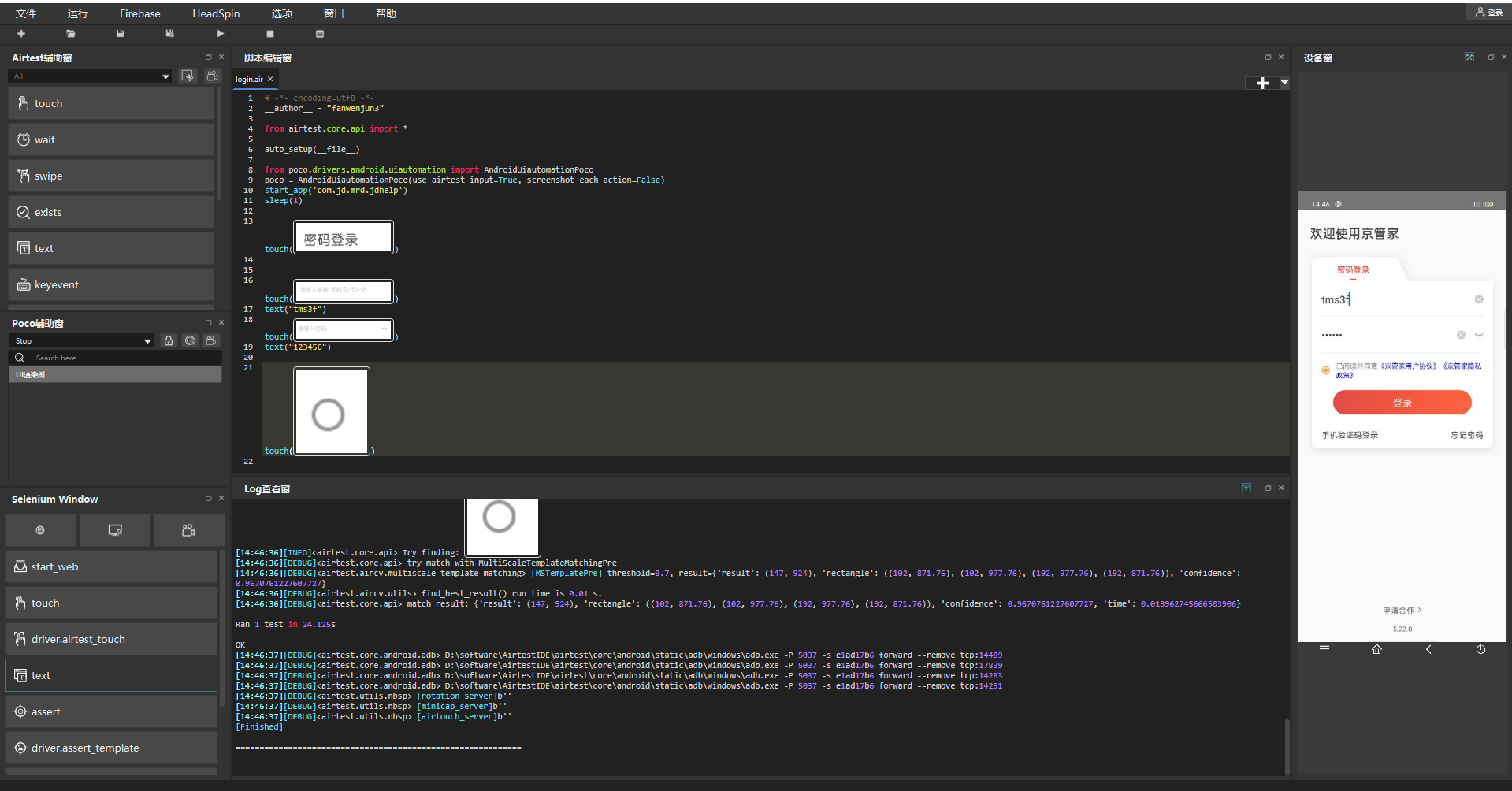1 Airtest 简介
Airtest 是一个跨平台的、基于图像识别的 UI 自动化测试框架,适用于游戏和 App,支持平台有 Windows、Android 和 iOS。Airtest 框架基于一种图形脚本语言 Sikuli,引用该框架后,不再需要一行行的写代码,通过截取按钮或输入框的图片,用图片组成测试场景,这种方式学习成本低,简单易上手。
2 Airtest 实践
APP 接入流水线过程中,赛博平台只支持 air 脚本,因此需要对京管家 APP 的 UI 自动化脚本进行的改造。如截图可见,AirtestIDE 的主界面由菜单栏、快捷工具栏和多个窗口组成,初始布局中的“设备窗口”是工具的设备连接交互区域。
air 脚本生成步骤:
通过 adb 连接手机或模拟器
安装应用 APK
运行应用并截图
模拟用户输入(点击、滑动、按键)
卸载应用
通过以上步骤自动生成了 .air 脚本,调试过程中我们可以在 IDE 中运行代码,支持多行运行以及单行运行,调试通过后可在本地或服务器以命令行的方式运行脚本:
.air 脚本运行方式:airtest run “path to your .air dir” —device Android
.air 脚本生成报告的方式:airtest report “path to your .air dir”
3 Airtest 定位方式解析
IDE 的 log 查看窗口会时时打印脚本执行的日志,从中可以看出通过图片解析执行位置的过程。下面就以 touch 方法为例,解析 Airtest 如何通过图片获取到元素位置从而触发点击操作。
@logwrapdef touch(v, times=1, **kwargs): """ Perform the touch action on the device screen :param v: target to touch, either a ``Template`` instance or absolute coordinates (x, y) :param times: how many touches to be performed :param kwargs: platform specific `kwargs`, please refer to corresponding docs :return: finial position to be clicked, e.g. (100, 100) :platforms: Android, Windows, iOS """ if isinstance(v, Template): pos = loop_find(v, timeout=ST.FIND_TIMEOUT) else: try_log_screen() pos = v for _ in range(times): G.DEVICE.touch(pos, **kwargs) time.sleep(0.05) delay_after_operation() return pos
click = touch # click is alias of t
复制代码
该方法通过 loop_find 获取坐标,然后执行点击操作 G.DEVICE.touch(pos, kwargs),接下来看 loop_find 如何根据模板转换为坐标。
@logwrapdef loop_find(query, timeout=ST.FIND_TIMEOUT, threshold=None, interval=0.5, intervalfunc=None): """ Search for image template in the screen until timeout Args: query: image template to be found in screenshot timeout: time interval how long to look for the image template threshold: default is None interval: sleep interval before next attempt to find the image template intervalfunc: function that is executed after unsuccessful attempt to find the image template Raises: TargetNotFoundError: when image template is not found in screenshot Returns: TargetNotFoundError if image template not found, otherwise returns the position where the image template has been found in screenshot """ G.LOGGING.info("Try finding: %s", query) start_time = time.time() while True: screen = G.DEVICE.snapshot(filename=None, quality=ST.SNAPSHOT_QUALITY) if screen is None: G.LOGGING.warning("Screen is None, may be locked") else: if threshold: query.threshold = threshold match_pos = query.match_in(screen) if match_pos: try_log_screen(screen) return match_pos if intervalfunc is not None: intervalfunc() # 超时则raise,未超时则进行下次循环: if (time.time() - start_time) > timeout: try_log_screen(screen) raise TargetNotFoundError('Picture %s not found in screen' % query) else: t
复制代码
首先截取手机屏幕 match_pos = query.match_in(screen),然后对比传参图片与截屏来获取图片所在位置 match_pos = query.match_in(screen)。接下来看 match_in 方法的逻辑:
def match_in(self, screen): match_result = self._cv_match(screen) G.LOGGING.debug("match result: %s", match_result) if not match_result: return None focus_pos = TargetPos().getXY(match_result, self.target_pos) return focus_pos
复制代码
里面有个关键方法:match_result = self._cv_match(screen)
@logwrapdef _cv_match(self, screen): # in case image file not exist in current directory: ori_image = self._imread() image = self._resize_image(ori_image, screen, ST.RESIZE_METHOD) ret = None for method in ST.CVSTRATEGY: # get function definition and execute: func = MATCHING_METHODS.get(method, None) if func is None: raise InvalidMatchingMethodError("Undefined method in CVSTRATEGY: '%s', try 'kaze'/'brisk'/'akaze'/'orb'/'surf'/'sift'/'brief' instead." % method) else: if method in ["mstpl", "gmstpl"]: ret = self._try_match(func, ori_image, screen, threshold=self.threshold, rgb=self.rgb, record_pos=self.record_pos, resolution=self.resolution, scale_max=self.scale_max, scale_step=self.scale_step) else: ret = self._try_match(func, image, screen, threshold=self.threshold, rgb=self.rgb) if ret: break return ret
复制代码
首先读取图片调整图片尺寸,从而提升匹配成功率:
image = self._resize_image(ori_image, screen, ST.RESIZE_METHOD)
接下来是循环遍历匹配方法 for method in ST.CVSTRATEGY。而 ST.CVSTRATEGY 的枚举值:
CVSTRATEGY = ["mstpl", "tpl", "surf", "brisk"]if LooseVersion(cv2.__version__) > LooseVersion('3.4.2'): CVSTRATEGY = ["mstpl", "tpl", "sift", "brisk"]
复制代码
func = MATCHING_METHODS.get(method, None),func 可能的取值有 mstpl、tpl、surf、shift、brisk,无论哪种模式都调到了共同的方法_try_math
if method in ["mstpl", "gmstpl"]: ret = self._try_match(func, ori_image, screen, threshold=self.threshold, rgb=self.rgb, record_pos=self.record_pos, resolution=self.resolution, scale_max=self.scale_max, scale_step=self.scale_step)else: ret = self._try_match(func, image, screen, threshold=self.threshold, rgb=self.rgb)
复制代码
而_try_math 方法中都是调用的 func 的方法 find_best_result()
@staticmethoddef _try_match(func, *args, **kwargs): G.LOGGING.debug("try match with %s" % func.__name__) try: ret = func(*args, **kwargs).find_best_result() except aircv.NoModuleError as err: G.LOGGING.warning("'surf'/'sift'/'brief' is in opencv-contrib module. You can use 'tpl'/'kaze'/'brisk'/'akaze'/'orb' in CVSTRATEGY, or reinstall opencv with the contrib module.") return None except aircv.BaseError as err: G.LOGGING.debug(repr(err)) return None else: return ret
复制代码
以 TemplateMatching 类的 find_best_result()为例,看一下内部逻辑如何实现。
@print_run_timedef find_best_result(self): """基于kaze进行图像识别,只筛选出最优区域.""" """函数功能:找到最优结果.""" # 第一步:校验图像输入 check_source_larger_than_search(self.im_source, self.im_search) # 第二步:计算模板匹配的结果矩阵res res = self._get_template_result_matrix() # 第三步:依次获取匹配结果 min_val, max_val, min_loc, max_loc = cv2.minMaxLoc(res) h, w = self.im_search.shape[:2] # 求取可信度: confidence = self._get_confidence_from_matrix(max_loc, max_val, w, h) # 求取识别位置: 目标中心 + 目标区域: middle_point, rectangle = self._get_target_rectangle(max_loc, w, h) best_match = generate_result(middle_point, rectangle, confidence) LOGGING.debug("[%s] threshold=%s, result=%s" % (self.METHOD_NAME, self.threshold, best_match)) return best_match if confidence >= self.threshold else Non
复制代码
重点看第二步:计算模板匹配的结果矩阵 res,res = self._get_template_result_matrix()
def _get_template_result_matrix(self): """求取模板匹配的结果矩阵.""" # 灰度识别: cv2.matchTemplate( )只能处理灰度图片参数 s_gray, i_gray = img_mat_rgb_2_gray(self.im_search), img_mat_rgb_2_gray(self.im_source) return cv2.matchTemplate(i_gray, s_gray, cv2.TM_CCOEFF_NORMED)
复制代码
可以看到最终用的是 openCV 的方法,cv2.matchTemplate,那个优先匹配上就返回结果。
4 总结
使用过程中可以发现 Airtest 框架有两个缺点:一是对于背景透明的按钮或者控件,识别难度大;二是无法获取文本内容,但这一缺点可通过引入文字识别库解决,如:pytesseract。
对不能用 UI 控件定位的部件,使用图像识别定位还是非常方便的。UI 自动化脚本编写过程中可以将几个框架结合使用,uiautomator 定位速度较快,但对于 flutter 语言写的页面经常有一些部件无法定位,此时可以引入 airtest 框架用图片进行定位。每个框架都有优劣势,组合使用才能更好的实现目的。
作者:京东物流 范文君
来源:京东云开发者社区













评论